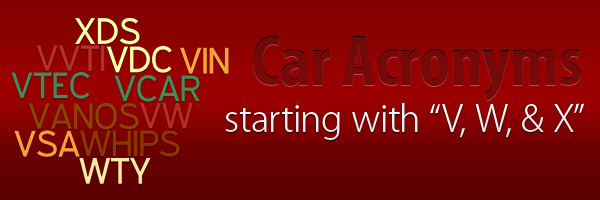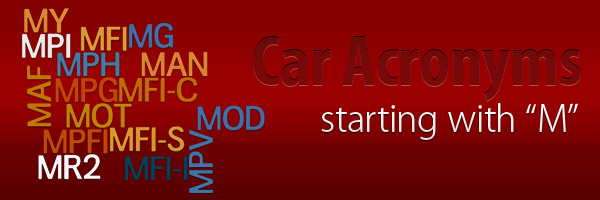VANOS – Variable camshaft timing
VANOS is a variable timing system developed by BMW. VANOS uses the drive gear in order to move the camshafts, thus varying the timing of the valves. At low engine speeds, the intake valves open later, improving idling quality. At moderate speeds, the valves open earlier, requiring greater torque and allowing exhaust gas to recirculate inside combustion chambers, reducing fuel consumption and exhaust emission. At high engine speeds, intake valves are opened later, returning to full power. The process increases torque and improves fuel efficiency and emissions management.
VCAR – Vehicle condition alert register
The vehicle condition alert register is a British database of cars that have been declared insurance “write offs” due to damage sustained during an accident or theft. The cars are classified in the register based on the extent of the damage. Category A cannot be driven and have no salvageable parts. Category B cars also cannot be driven but have some salvageable parts. Category C cars are drivable after extensive repairs and upon passing inspection. Category D cars are drivable after minor repairs.
VDC – Vehicle dynamics control
Used in Infiniti and Nissan cars, VDC is very similar to ESP. The system monitors steering and vehicle direction during normal driving by comparing the angle of the steering wheel to the vehicle’s lateral acceleration, yaw, and individual road wheel speeds. If the system detects a probable loss of control (the vehicle is not going in the direction that the steering wheel is pointing), it will intervene and attempt to correct the problem by braking individual wheels in order to direct the vehicle in the driver’s intended direction.
VIN – Vehicle identification number
A VIN Is a unique serial number given to each individual motor vehicle by the automotive industry. The VIN consists of 17 characters that are determined based on the standards of the country in which it’s produced. The first characters of any VIN are determined by the country code correlating to where the vehicle was manufactured.
VSA – Vehicle stability assist. System similar to ESP
Used in Acura cars, VSA is very similar to ESP. The system monitors steering and vehicle direction during normal driving by comparing the angle of the steering wheel to the vehicle’s lateral acceleration, yaw, and individual road wheel speeds. If the system detects a probable loss of control (the vehicle is not going in the direction that the steering wheel is pointing), it will intervene and attempt to correct the problem by braking individual wheels in order to direct the vehicle in the driver’s intended direction. In addition to anti-lock brakes, VSA utilizes a traction control system to prevent wheel slip during acceleration.
VSC – Vehicle stability control
Used in Toyota cars, VSC is very similar to ESP. The system monitors steering and vehicle direction during normal driving by comparing the angle of the steering wheel to the vehicle’s lateral acceleration, yaw, and individual road wheel speeds. If the system detects a probable loss of control (the vehicle is not going in the direction that the steering wheel is pointing), it will intervene and attempt to correct the problem by braking individual wheels and reducing engine power in order to direct the vehicle in the driver’s intended direction
VTEC – Variable Valve Timing
VTEC is a variable valve timing system developed by Honda designed to increase the fuel efficiency of a four-stroke internal combustion engine. The system utilizes two camshaft profiles which the engine control unit choses between based on factors such as engine oil pressure, engine temperature, engine speed, vehicle speed and throttle position. When the conditions warrant it, the ECU is programmed to switch to a high lift cam lobe when engine output will be improved. At a switch point, the high RPM follower binds to the low RPM ones and the valves open for a longer period of time. The result of this continuous process is a combination of high RPM output and low RPM stability.
VVTI – Variable Valve Timing
VVTI is a variable valve timing system developed by Toyota that varies the timing of intake valves by adjusting the relationship between the camshaft drive and the intake camshaft. Engine oil pressure is applied to an actuator, adjusting the position of each camshaft. This causes adjustments in the overlap time between the exhaust valve closing and the intake valve opening. The end result is greater engine efficiency.
VW – Volkswagen
Volkswagen is the largest automobile manufacturer in Germany and the second largest in the world. It was founded in 1937 by Ferdinand Porsche, and is best known for producing the iconic Volkswagen Beetle.
WHIPS – Whiplash protection system
This system protects against whiplash injuries, or sudden distortion of the neck caused by extension. The injury commonly occurs as a result of rear impact causing a passenger’s head to be violently thrust forward. WHIPS is designed such that, upon impact, the backrest reclines the passenger’s head and pivots along with the passenger hips, absorbing much of the energy and reducing strain on the neck.
WTY – Warranty
A warranty is a written guarantee, given to a purchaser of a product by its seller, promising to compensate the purchaser or repair the product if necessary over the length of the agreement. New cars warranties generally last 3-5 years or until the car is driven a certain number of miles.
XDS – Electronic cross-axle traction control system
This term refers to a traction control system that has a driving cross-axle, which means that automotive cranks are positioned at a ninety-degree right angle in relation to one another. An electronic cross-axle traction control system fosters increased traction and more fluid maneuvering of a motorized vehicle, which is said to heighten driving pleasure and driving stability. In the instance of cornering, XDS will expel precisely the correct amount of torque, putting increased pressure on the inside wheels. In turn, wheel spin is minimized and the automobile’s grip on the road is increased to allow for a safer, calmer driving experience.








